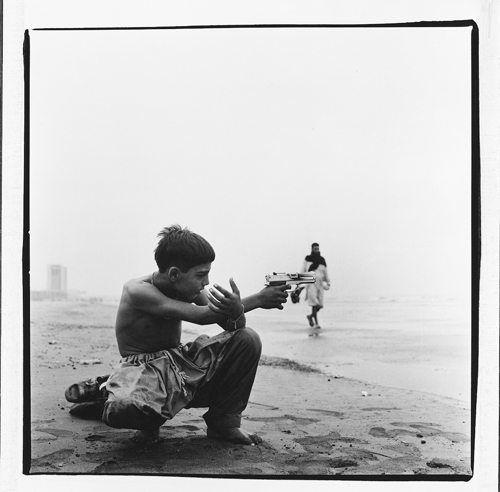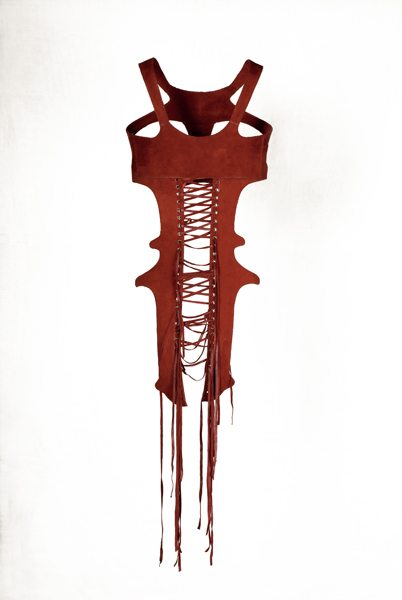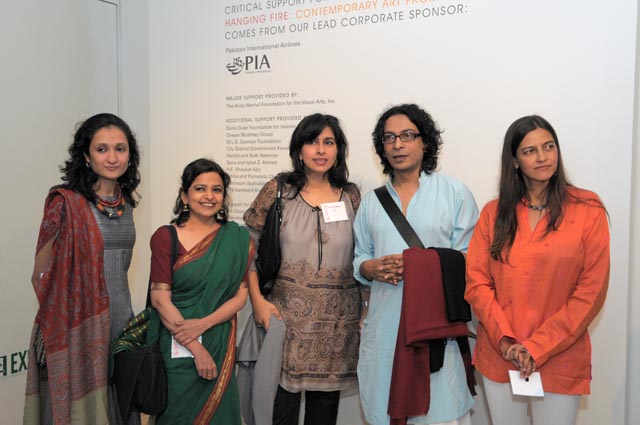
“I am basically a street photographer, documenting people, events, places, We live in and within boundaries of our fate. We are thrown into certain situations which are beyond our control. I document what I see, but I also give a small part of myself to the image.”
– Arif Mahmood – born 1960, Karachi; lives and works in Karachi
“The inspiration for my work stems directly from my sense of identity (gender/cultural) and the times we live in. I create work by chancing upon potent journalistic images, text, encounters, and experiences, as I conduct my affairs as an artist, a mother, and a woman.”
– Faiza Butt, born 1973, Lahore; lives and works in London
“I continue my engagement with the interpretation of traditional narratives and motifs of religious self-expression at their alleged crossroads with “modernity,” along different registers that range from the absurd to the sombre.”
– Hamra Abbas, born 1976, Kuwait; lives and works in Islamabad
“The Dis-Location and Red Carpet series, like much of my recent work, are an attempt to translate the physical, psychological, and temporal aspects of our current epoch into the “idea” of two dimensionality, whether it be represented in the form of painting, photography, video, or sculpture.”
– Rashid Rana, born 1968, Lahore; lives and works in Lahore

“The use of clothing in my work began as a strategy to explore the emotional content of the body through attire. Lingerie, armor, straight jackets, and other imagined pieces create multiple identities or personae. These objects address contemporary anxieties and desires, at a time when ideas about the ‘self’ seem unstable and rapidly shifting.
The steel structure of Spine is transformed through the stitching of red suede, and was inspired by the two-piece choli that is worn at weddings in the Subcontinent. Spine led me to rethink the function of the choli and the inherent contradictions it carries; it is, at the same time, flirtatious and oppressive.”
– Naiza Khan, born 1968, Bahawalpur, Punjab; lives and works in Karachi

Art in Troubled Times – Some milestones
1952
A group of Pakistani artists—among the first to have received a western education— establishes the Lahore Art Circle.
1958
General Ayub Khan establishes Pakistan’s first period of martial law, which brings censorship and suspension of regional rights. Art and culture receive government funding, which serves to soften the image of the military government.The Mayo School of Art (established 1875) in Lahore becomes the National College of Arts (NCA).
1961
Pakistan’s first private art gallery, the Gallery of Contemporary Art, opens in Rawalpindi.
1979
Zulfiqar Ali Bhutto is executed after being tried for conspiring to murder and rig elections. As part of Zia’s Islamization process, the Hudood Ordinance is enacted. The ordinance implements sharia, or Islamic, law for the punishment of theft, the drinking of alcohol, and extramarital sex. Artistic production comes under government scrutiny for the inclusion of un-Islamic form and content. Landscape, calligraphy, and nonfigurative abstraction receive patronage above other forms.
1982
Zia’s program of Islamization, which marginalizes non-Muslims and women, is resisted by educated women, journalists, local law associations, and human rights activists. This marginalization results in the formation of the Women’s Action Forum (WAF) and fosters the evolution of a variety of independent artistic trends in the practices of women artists.
1984
The Presidential Ordinance enacts the Law of Evidence, which renders the evidence of two women equal to that of one man.
1988
After Zia is killed in a plane crash, Benazir Bhutto is elected prime minister. Under Bhutto’s government, artists enjoy freedom to explore new ideas and iconography; many artists look to popular and folk culture, literature, urban mythologies, and miniature painting for inspiration.
2001
Musharraf appoints himself president while remaining army chief.
Following the attacks of September 11, Musharraf becomes a key ally of the United States in its fight against terrorism. The United States lifts some of the sanctions imposed on Pakistan.
(Text and photos courtesy: Asia Society)
